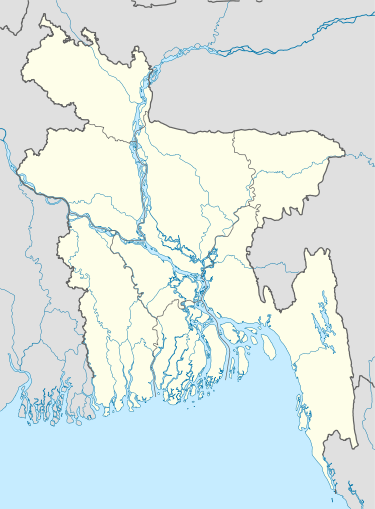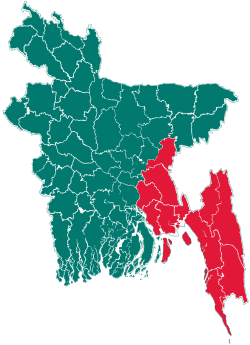Ramu Upazila
| Ramu রামু | |
|---|---|
| Upazila | |
 Ramu Location in Bangladesh | |
| Coordinates: 21°27.5′N 92°6′E / 21.4583°N 92.100°ECoordinates: 21°27.5′N 92°6′E / 21.4583°N 92.100°E | |
| Country | Bangladesh |
| Division | Chittagong Division |
| District | Cox's Bazar District |
| Area | |
| • Total | 391.71 km2 (151.24 sq mi) |
| Population (1991) | |
| • Total | 167,480 |
| • Density | 428/km2 (1,110/sq mi) |
| Time zone | BST (UTC+6) |
| Website | Official Map of Ramu |
Ramu (Bengali: রামু) is an Upazila of Cox's Bazar District in the Division of Chittagong, Bangladesh.[1]
Geography
Ramu is located at 21°27′30″N 92°06′00″E / 21.4583°N 92.1000°E . It has 26964 units of house hold and the area of the town is 22.03 km2.
Demographics
As of the 1991 Bangladesh census, Ramu has a population of 167480. Males constitute 51.41% of the population, and females 48.59%. This Upazila's eighteen up population is 74742. Ramu has an average literacy rate among town people is 34%., and the national average of 32.4% literate.Ramu thana was transformed into an upazila in 1983. It consists of 9 union parishads, 39 mouzas and 102 villages.[2]
Administrative
Ramu has 9 Unions/Wards, 39 Mauzas/Mahallas, and 102 villages. According to tradition Ramu, Cox's Bazar got its name from the Ramu dynasty of the Arakan. It came under the Mughals when Chittagong was captured by them and during that time a thirteen feet high Buddha statue was found.
Ramu, Cox's Bazar is a village with an excellent charm of its own which is spread here in the form of monasteries, temples and various Buddhist statues and images. Here you would find weavers busy in their trades that are taking place in open workshops and craftsmen engaged in making hand made cigars from their houses which look like pagodas. In Ramu, Cox's Bazar you would find various monasteries and Buddhist temples where you would see statues and images of Buddha in gold, bronze and various other metals and studded with precious stones.
The most important sightseeing attraction of Ramu, Cox's Bazar is the beautiful Buddhist temple that you would find near Bakkhali on Tiger Canal. Here you would find various Buddhist relics and Burmese handicrafts. The best attraction is however, the huge bronze statue of Buddha which is thirteen feet high set over a 6 feet high pedestal. It is the biggest among the Buddha statues that are found in whole of Bangladesh. The monastery is also famous because of its intricate wood carvings that you would find in the monastery. Ramkot is another sight seeing attraction since it is said that the stone grinder used by Sita while she was in Lanka is preserved here and Rama also met Sita here.
ramu This is a typical Buddhist village, about 16 km. from Cox's Bazar, on the main road to Chittagong. There are monasteries, khyangs and pagodas containing images of Buddha in gold, bronze and other metals inlaid with precious stones.
One of the most interesting of these temples is on the bank of the Baghkhali River. It houses not only interesting relics and Burmese handicrafts but also a large bronze statue of Buddha measuring thirteen feet high and rests on a six feet high pedestal. The wood carving of this khyang is very delicate and refined.
The village has a charm of its own. Weavers ply their trade in open workshops and craftsmen make handmade cigars in their pagoda like houses.
References
- ↑ Muhammad Tawhid Hossain Chowdhury (2012). "Ramu Upazila". In Sirajul Islam and Ahmed A. Jamal. Banglapedia: National Encyclopedia of Bangladesh (Second ed.). Asiatic Society of Bangladesh.
- ↑ "Population Census Wing, BBS.". Archived from the original on 2005-03-27. Retrieved November 10, 2006.
| |||||||||||||||||||||||||||||||||||||||||||||||||||||
